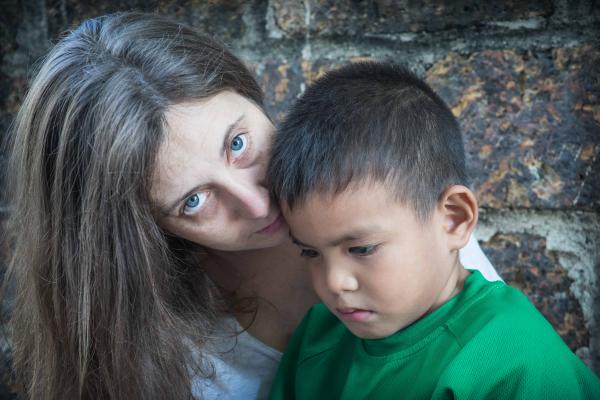
Wouldn't it be nice if you could trust family members, teachers and babysitters with your children? Unfortunately, you can't trust everyone you want to these days. Most especially, you have to trust your eyes more than your heart in child abuse cases.
There are four recognized forms of child abuse: physical, sexual, emotional and neglect. All types of child abuse have lasting emotional and sometimes physical consequences. If you want to know if your child is abused, look for these signs:
Physical abuse signs
You may think the signs are obvious, but children do their best to hide them. Children do get injured while playing, so you will need to look for both physical and behavioral signs:
Physical indicators:
-
Symmetrical or frequent bruising in the shape of fingerprints or belt buckles around the head, abdomen, between the wrists and elbows, inside the legs, back, on the genitals and buttocks
-
Some bruising may have a whip-like or patterned appearance
-
Internal bleeding causes skin to be discolored or blood-filled lumps to appear.
-
Bruising and swelling along the scalp or eyes from hair being violently pulled
-
Bite marks or burns (commonly cigarette burns)
-
Sensitivity or complaints about soreness and stiffness
-
Multiple sprains or broken bones at different stages of healing - particularly rib and leg fractures
Behavioral indicators:
-
Slowed mental, physical and emotional development accompanied by the following: withdrawal, aggression, regression, anxiety, low self-esteem, depression or suicidal thoughts
-
Wariness of physical contact especially from an adult
-
The child tells you they are being injured, but the explanation of an injury changes or it's not believable
-
Abuses pets or animals
-
Changes in behavior at school or home such as wearing long sleeves in warm weather to hide injuries
Sexual abuse signs
This kind of abuse is easier to hide than physical abuse. You will need to pay attention to changes in your child's behavior, especially if their behavior changes around a certain person.
Physical indicators:
-
Difficulty walking or sitting due to bruising in the inner thigh or genital area
-
Complaining about genital or anal itching, along with pain, bleeding or discharge
-
Pregnancy, contraction of a sexually transmitted diseases or urinary infections
-
Frequent yeast infections or sore throats
-
Bleeding through pants or torn, stained underwear
-
Regressing to child-like behaviors (thumb-sucking, fear of the dark, wetting the bed, etc.)
-
Receiving unexplained gifts or money
-
Self-harm
Behavioral indicators:
-
Secretive behavior and using phrases like, "I don't like that person" or "I've got a secret"
-
Advanced sexual knowledge, more than is age appropriate or abnormally seductive behavior
-
Unexplained fear of physical contact, or a specific gender
-
Nightmares or crying in the night
-
Becoming clingy
-
Changes in clothing or eating habits
Emotional abuse signs
Like sexual abuse, most signs of emotional abuse are evident in behavioral changes.
Physical indicators:
-
Wetting or soiling oneself at an inappropriate age
-
Alcohol or drug abuse
-
For infants, flat or bald spots on the head
-
Nervous disorders like rashes, hives, facial tics and stomach aches
-
Frequent headaches, nausea or abdominal pains
Behavioral indicators:
-
Extreme emotions (more fearful, anxious, angry, sad or cruel to others than normal)
-
Does poorly in school or delays in emotional and intellectual growth
-
Eating and speech disorders (including talking less or stopping all communication)
-
Anti-social behavior, an inability to play like most children do or negative attention-seeking behavior
-
Acts like an adult or "mothers" other children, over compliant, too well-mannered or too neat
Neglect signs
Neglect generally happens at home. If your children spend a lot of time away from your home, you might want to make sure they are not being neglected, especially if they claim no one takes care of them.
Physical indicators:
-
Inadequately dressed for the weather
-
Excessively listless, tired or sick or lacks proper immunizations
-
Poor hygiene or unattended medical or dental problems
-
Constantly hungry, or often begging, collecting or stealing food
Behavioral indicators:
-
Cares for younger siblings
-
Craves unusual amounts of attention
-
Unusual school attendance
-
Lack of attachment to other adults
-
Plays in dangerous environments
Keep in mind two things. Some of these signs, particularly behavioral changes, could be caused by something traumatic like a divorce or a death in the family. And some of the signs listed under one form of abuse can also appear in other forms.
Knowing the signs of abuse is important, but discovering your child is being abused is a delicate matter. Instead of confronting them, build a loving relationship with them so they feel comfortable talking to you.
When your children open up to you about any form of abuse, strive to put aside emotions like shock or disgust, according to the Children's Bureau. Be as comforting as possible and don't interrogate. Too many questions may scare your child, so be as conversational as possible.
While you should carefully observe your children for signs of abuse, keep an eye out for other children, and report any signs of abuse you witness to authorities. You never know when your observations could save a child in danger.
This data and information was collected from: Project Harmony, WebMD, Stanford medicine, Tennyson Center for Children, Parents Protect, Massachusetts Government Health and Human Services, ChildWelfare.gov, DC Child and Family Services, ChildMatters.org, Baby Center, All4Kids.org, New York Office of Children and Family Services, and the National Society for the Prevention of Cruelty to Children.

